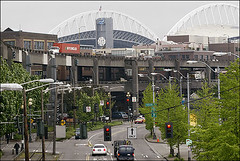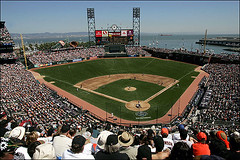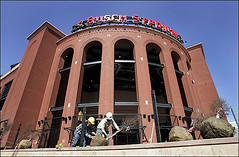Sports economists ask why do cities continue to subsidize teams... (Once again, DC bucks prevalent development trends)
 In 1997, Seattle Seahawks owner (and Microsoft cofounder) Paul Allen spent $6.2 million on a successful advertising campaign to persuade Washington voters to pay $327 million for a new stadium, now called Qwest Field. (AP Photo) Note: Paul Allen was one of the founders of Microsoft and he is one of the wealthiest people not just in the United States, but in the world. He needs a subsidy?
In 1997, Seattle Seahawks owner (and Microsoft cofounder) Paul Allen spent $6.2 million on a successful advertising campaign to persuade Washington voters to pay $327 million for a new stadium, now called Qwest Field. (AP Photo) Note: Paul Allen was one of the founders of Microsoft and he is one of the wealthiest people not just in the United States, but in the world. He needs a subsidy?According to this article from the Opinion section of Sunday's Boston Globe, "Ballpark figures: Sports economists agree that cities--and taxpayers--get close to nothing from spending public money on sports teams. What they haven't figured out is why we're still doing it."
From the article:
FOR THE PAST FEW MONTHS, a dispute has been simmering between the Red Sox and Boston Mayor Thomas Menino. The Sox, along with some neighboring businesses and hospitals, have been lobbying for $55 million in state money for bus, subway, and road improvements near Fenway Park that would enhance the value of the property in the area, much of which the team owns and is developing. Repeatedly and firmly, the mayor has said he thinks the money would be better spent elsewhere.
Menino hasn't always been so frugal with the local baseball club. The last time the Red Sox asked for public funds, in a controversial and ultimately failed 2000 bid to build a new ballpark, Menino offered $212 million in city funds-on top of a state infrastructure package nearly twice the size of the one currently under consideration. City officials say the change is merely an adjustment to a new, straitened financial climate. But they also allow that the mayor is no longer sure it makes economic sense to grant the team's financial wishes.
 Built in 2000 and paid for almost entirely by the Giants, SBC Park has spurred a building boom along a formerly abandoned stretch of San Francisco's waterfront. (Getty Images Photo / Stephen Dunn)
Built in 2000 and paid for almost entirely by the Giants, SBC Park has spurred a building boom along a formerly abandoned stretch of San Francisco's waterfront. (Getty Images Photo / Stephen Dunn)  Photo by Mike Kepika of the San Francisco Chronicle. People leaving the streetcars to see a Giants game at PacBell Park. Note the leveraging of a pre-existing investment in transit.
Photo by Mike Kepika of the San Francisco Chronicle. People leaving the streetcars to see a Giants game at PacBell Park. Note the leveraging of a pre-existing investment in transit.For a decade and a half, the belief that sports teams were economic drivers helped persuade cities and states to shower billions of dollars on major league sports teams, most of it to build state-of-the-art stadiums like the Detroit Tigers' Comerica Park, the Seattle Seahawks' Qwest Field, and perhaps most famously the Baltimore Orioles' Camden Yards-the 1992 ballpark that set the standard not only for how ballparks would look, but how they would be built and paid for. ''Build the Stadium," went a 1997 slogan for a new San Francisco football stadium, ''Create the Jobs!"
But Menino isn't the only one to have had second thoughts in recent years about the wisdom of such largesse. Bitter public disputes have broken out in a few other sports cities over whether to give public funds to the local team. The most recent ballpark to be built, St. Louis's new Busch Stadium, was paid for almost entirely by the Cardinals after city and state officials refused to commit public funds. A proposed Manhattan stadium for the New York Jets died last year when the state government refused to chip in the asked-for $300 million. The political battle over the funding of Miller Park, in Milwaukee, was so vitriolic that former Wisconsin governor Tommy Thompson refused to set foot in it for years after it was built.
I find it incredibly interesting that these kinds of "big projects" get justified not on economics, but because it makes us "feel better about ourselves" or "makes our city 'big league.'"
I'd feel my city is "big league" if it possessed uniformly great schools, libraries, parks, and transit. That people are employed and healthy. That the city is safe for all people regardless of income status.
(I was thumbing through a introductory sociology textbook yesterday and in the section on "city life" lists Gans' five types of city residents: cosmopoles; singles; ethnic villagers; deprived; and trapped. How about working towards a city where through opportunity and support no one is deprived or trapped?)
That we had a city of citizens truly engaged in civic life, and the governmental, political, community, and neighborhood institutions and organizations were structured around this fact. That as a city we had "best-in-class" initiatives that were successfully innovative in small business development, community-based health initiatives, and civic engagement.
And somehow, that we worked in education about urban design, cultural heritage, and placemaking at all levels.
That's where I'd rather see our priorities, directing tax revenues towards these fundamental building blocks, the essential physical and social infrastructure necessary for the creation and maintenance of a truly livable city.
This undergirding philosophy colors how I look at and write about "Rebuilding Place."
 The St. Louis Cardinals had to pay for the new Busch Stadium, due to open this spring, though lawmakers did chip in a loan and some tax breaks. (Reuters Photo)
The St. Louis Cardinals had to pay for the new Busch Stadium, due to open this spring, though lawmakers did chip in a loan and some tax breaks. (Reuters Photo)Index Keywords: stadiums-arenas



0 Comments:
Post a Comment
<< Home